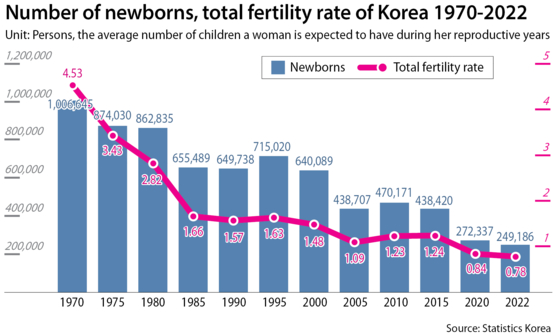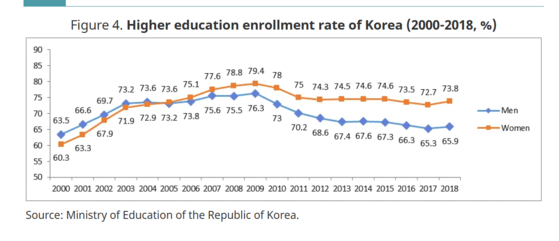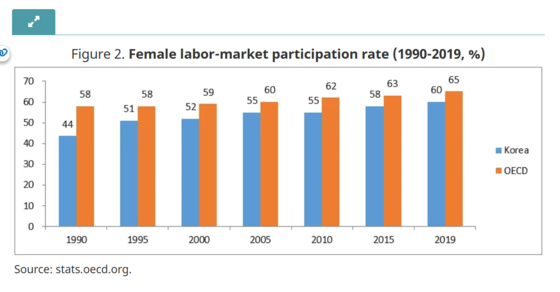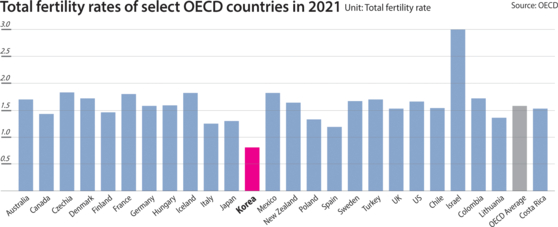[WHY] Don't Koreans have kids anymore?
![Kindergarteners in Daegu take part in a fire drill on Oct. 30. [NEWS1]](https://koreajoongangdaily.joins.com/data/photo/2024/01/30/c1b0089d-a356-48f1-a4b9-76ea838c1b9f.jpg)
Kindergarteners in Daegu take part in a fire drill on Oct. 30. [NEWS1]
It could If current demographic trends hold. Simply put, Koreans are not making enough babies.
Some blame remnant Confucian ideals on family dynamics that render marriage and childbirth an increasingly difficult option for career-oriented women.
Others cite colossal economic costs that go into a child’s private education and skyrocketing housing prices.
Still others point to the long working hours — some of the longest in the Organisation for Economic Co-operation and Development (OECD) — which inevitably lead to fewer hours spent at home with family.
Korea's ultralow birthrate may pose an existential threat, with the nation's population projected to become the second oldest in the world by 2050, halve by 2100 and go extinct by 2750.
It’s hard to pinpoint a single factor driving this demographic trend, but many may fall within the norms and culture of how Koreans live and work.
Addressing an audience in Seoul last May, Oxford University demographer David Coleman pointed to four possible underlying causes: patriarchy, marriage, workism and education fever.
Are existing Korean lifestyles simply not sustainable?
To find out, the Korea JoongAng Daily spoke with single men and women, married but childless couples, parents young and old, policymakers, economists and demographers.
Is Korea going extinct?
The UN Population Fund estimates that two-thirds of the world population lives in a country or region with fertility rates lower than 2.1 — the minimum total fertility rate needed to maintain the current population size.
But what’s particularly scary about Korea’s dropping fertility rate is its unmatched rapidity and consistency, according to some demographers.
The total fertility rate, which measures the average number of births a woman is expected to give during her reproductive years, hit 0.78 in Korea in 2022 and is expected to sag further to 0.73 by the end of this year.

Graphic created by the Korea JoongAng Daily
Korea’s fertility rate started showing some red-flag signs in the early 2000s when it dipped below 1.3, considered the red line between a low fertility rate and the lowest of the lows.
Contrary to other countries that bounced back from seasons of low fertility, Korea’s collective infertility has grown worse almost every year since.
“I fear they will break their backs in sustaining such a demographic structure.” - Kim Tai-yoo, professor of economics at Seoul National University
The indices are not good news for a country that rewrote the book on development by becoming a top-10 economy within a single generation, going from an international aid recipient to a donor.
Coupled with an aging population, experts have warned the country’s young population will not be able to sustain itself within a few years.
“Some have started to ask whether the younger generation will struggle to take on the challenges of such rapidly aging and dwindling population,” said Kim Tai-yoo, professor of economics at Seoul National University, in a recent interview. “I fear they will break their backs in sustaining such a demographic structure.”
Too Confucian?
“Women get overloaded,” said Coleman during his lecture in Seoul in May, referring to the drop in fertility in East Asia and southern Europe, whereby women bear the brunt of child-rearing.
“They try to do their best but must exercise portion control in these very widely ranging responsibilities,” he said. “And so you tend to get low birthrates as a consequence.”
In Korea, a woman’s role at home is heavily influenced by Confucianism.
In the nation's traditionally patriarchal society, women were expected to assume the role of supporters of their husbands, often sacrificing their dreams or ambitions outside of domestic life so their husbands could reach professional success, bringing honor to the family.
The times have changed, with Korean women attaining higher levels of education than men and working more than ever.

Four out of 10 women in Korea have quit their jobs after giving birth as of last year, according to the Ministry of Gender Equality and Family. According to Statistics Korea, around 95 percent of women who left their jobs between 2017 and 2022 did so after getting married, giving birth, or being the primary caregiver at home.
Of the couples who took parental leaves last year, 28.9 percent were men, and 71.1 percent were women, according to the Ministry of Employment and Labor.
In short, when push came to shove, more women than men hit the brakes on their careers.
Single women dedicated to their careers in Korea are not unaware of this “stalled gender revolution in the homefront,” said Kate Choi, a social demographer at Western University.
“As a result, women who want career advancement don’t want to assume the heavy burden of having to do both work [in the office] as well as at home,” said Choi. “These women are delaying and potentially even foregoing marriages and parenthood altogether.”

Many Korean women approach the choice between career and marriage and other decisions that follow, like giving birth, as a zero-sum game.
“I do see a lot of career-driven women in the industry who prioritize their career over everything because how can they not?” said Kim, a single woman in her 30s who has worked in local and international organizations on human rights.
For Kim, marriage and childbirth are not the necessary means to happiness, something she feels she can better attain with her career, friends and family.
“If traditional gender roles remain the same, [marriage and children] would require a lot of effort and energy that I think would be better channeled elsewhere at this stage of my life,” she said.
It also doesn’t help that women who choose to put their careers on hold to prioritize their marriage or children are often penalized when they try to return to work.
On average, women who quit their jobs to care for matters at home do so at age 29 and cannot rejoin the workforce for some 8.9 years, according to the Ministry of Gender Equality and Family.

Graphic created by the Korea JoongAng Daily
Afraid of hurting their career, some women who want both family and a career push off marriage and children, resorting to in vitro fertilization, commonly referred to as IVF.
The total number of women who underwent IVF treatment grew by nearly 50 percent between 2018 and last year to reach more than 200,000, according to the Health Ministry’s data released by lawmaker Baek Jong-hean’s office recently.
The average age of mothers giving birth to their first child in Korea was 32.6 in 2021, the highest among OECD nations. The average age hit 33 last year, according to Statistics Korea.
![[PIXABAY]](https://koreajoongangdaily.joins.com/data/photo/2024/01/30/6a657781-e819-45ad-bc03-3a7e18f52efb.jpg)
[PIXABAY]
Unaffordable parenthood
In a survey last year, 44.2 percent of men said they were disinterested in marriage, mainly citing the financial burden of married life.
Included in that burden are skyrocketing housing prices and the colossal costs of private education.
“Heavy investment in education and rapid gains in human capital, for example, may have been the social force that fueled the rapid economic growth after the Korean War,” writes Choi in her research. “However, the expectation of investing enormous amounts of resources in children may be the very thing that has contributed to Korea’s retreat from marriage and ultralow fertility.”
![Students wait to cross the street towards a building of private academies, or hagwon, in Daechi-dong of Gangnam District, southern Seoul, on March 4, 2021. [YONHAP]](https://koreajoongangdaily.joins.com/data/photo/2024/01/30/7f05136e-b695-4330-a724-1aed3f813675.jpg)
Students wait to cross the street towards a building of private academies, or hagwon, in Daechi-dong of Gangnam District, southern Seoul, on March 4, 2021. [YONHAP]
Each household spent an average of 410,000 won per month on their child’s private education last year, which was 11.8 percent higher than in 2022.
“I had to compete really hard to get to where I am today, and if I have a child, it would mean he or she would have to do the same if not more." - Jeong, a single in his 30s
Educator fervor starts early for most children in Korea because of the high competition to get into the best schools in the nation.
In Korea, only the top 2 percent of the nation's brightest minds attend the SKY universities, an acronym derived from the first letters of Korea's top three universities: Seoul University, Korea University and Yonsei University.
Attendance at SKY is associated with employment prospects, as over half of Korea’s lawmakers, ministers, heads of local governments, corporate executive positions, lawyers and doctors are SKY graduates, according to a study by Ma Gang-rae, an urban planning and economy professor at Chung-Ang University.
The financial pressure and the highly competitive environment are not conducive for aspiring parents.
“Frankly speaking, I don’t see a better future for the next generation,” said a single man in his 30s surnamed Jeong, who works as a software engineer in Yongin, Gyeonggi. “I had to compete really hard to get to where I am today, and if I have a child, it would mean he or she would have to do the same if not more. I am not sure if I want to bring a child into such a difficult environment.”
The so-called Easterlin Effect has been long discussed among sociologists and economists. The theory is that men and women would procreate more only when the expected standard of living is higher than the ones they experienced growing up.
![Apartment complexes in southern Seoul on June 7. [YONHAP]](https://koreajoongangdaily.joins.com/data/photo/2024/01/30/d2f01153-3987-493d-94e5-72deffd1bc71.jpg)
Apartment complexes in southern Seoul on June 7. [YONHAP]
Jeong, who has seen friends and coworkers get married and lead childless lives, says he can understand why.
“It’s been one competition after another, and I think it makes sense for young people to have some time for themselves,” he said.
How does one fix culture?
Caveats such as, “Should gender equality be more present at work?” or, “If I had more time outside of work,” were often used by singles as conditions to change their minds about having children, while couples and singles alike pointed to high-competition society for their decisions to remain childless or not have more children.
A slower, more equal way of life could help resolve Korea's low fertility.
Signs indicate that cities that offer a better work-life balance enjoy higher fertility.
Sejong, home to several ministries and government bureaus, is the only city in the nation with a total fertility rate higher than 1. The city has been ranked consistently high in annual surveys by the Labor Ministry on work-and-life balance.
![A customer takes a look at some infant socks at a baby products fair in Ilsan, Gyeonggi, on May 4. [NEWS1]](https://koreajoongangdaily.joins.com/data/photo/2024/01/30/465a0168-9c07-4c18-93d7-5547d8c28949.jpg)
A customer takes a look at some infant socks at a baby products fair in Ilsan, Gyeonggi, on May 4. [NEWS1]
When Korea first implemented paternity leave in 1995, the first man to do so — a schoolteacher — was considered such a rarity that his story made the papers in September 1996.
Though paternity leave rates today take up only a third of total parental leave, the numbers have grown nearly twentyfold from 2010 to 2020, according to Statistics Korea. In 2020, a total of 38,511 men took paternity leave.
There are also signs that the culture around marriage and childbirth may be changing, which could bode well for fertility.
Births outside of wedlock comprised 41.5 percent of all births across OECD nations in 2018. In Korea, the rate is just 2.2 percent.
![[OECD]](https://koreajoongangdaily.joins.com/data/photo/2024/01/30/f41f3ccf-e771-48de-890d-77fb7157daab.jpg)
[OECD]
However, more young adults say this could change. As many as 65.2 percent of Koreans in their 20s and 30s surveyed by Statistics Korea last year said it is acceptable for a couple to live together without getting married, which was 5.5 percentage points higher than in 2018.
When asked if it was acceptable for such unwed couples to have children, 34.7 percent said yes, an increase of 3.4 percentage points from 2018.
Some experts said policies should nudge cultural changes.
The Korean government has spent 280 trillion won since 2006 tweaking corporate and individual behavior to boost fertility. These pro-natalist programs included cash rewards for parents who take parental leave, tax incentives for companies that keep people returning from parental leave employed for more than a year, or education or housing subsidies for families with two or more children.
“There isn't any evidence of a bounce back of fertility rates as a result of the small amount of stipends or monthly stipends that people are getting for a short amount of time,” said Choi. “It takes hundreds of thousands of dollars to raise a child, that the subsidies can pale in comparison. Potentially, what is much more effective is actually building the social infrastructure, like a public childcare system, to turn the tide around on what's been called a population disaster.”
BY ESTHER CHUNG [chung.juhee@joongang.co.kr]










with the Korea JoongAng Daily
To write comments, please log in to one of the accounts.
Standards Board Policy (0/250자)